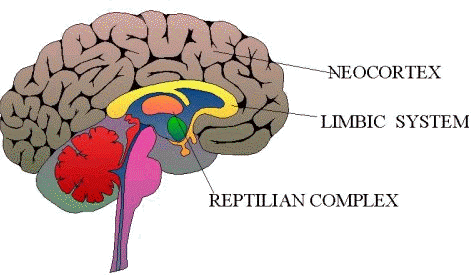The Trinitarian or Trinitarian brain is a theory developed by american physician and neuroscientist Paul MacLean, which states that humans have the brain divided into three distinct units, which develop at different times in our evolutionary cycle, so it is said to have been created from the bottom up.
In other words, the oldest and most primitive part of the brain always develops in the uterus, while the emotional brain is organized during the first six years of life and the prefrontal cortex develops further.
- Advanced physics and technology have made neuroscience one of the most popular areas of research and have led to a better understanding of the functioning of the Trinitarian brain (three types of brain in one).
- Below.
- We will describe the differences and characteristics of each of them.
The reptile brain is known as the ancient animal brain. It is located in the trunk of the brain, just above where the spinal cord reaches the skull, is the most primitive part of the human being and begins its development even in the uterus, so it is responsible for everything that newborns can do (breathe, eat, sleep, wake up, cry, urinate, defecate?).
The brain stem, along with the hypothalamus, controls the body’s energy levels, called homeostasis, a term that refers to maintaining stability, the body’s internal balance. The functions controlled by the reptile brain are fundamental, although their importance is sometimes overlooked when we simply think of more advanced functions of our minds, such as abstract thinking.
A number of psychological problems are related to the difficulties of these basic functions for which the reptile brain is responsible, for example, any imbalances suffered by the body should be taken into account in any trauma treatment.
The emotional or limbic brain is located just above the reptile brain, in the center of the central nervous system (CNS), and begins to develop as soon as the baby is born. Depending on the child’s experience, genetic makeup and innate temperament, this is formed by the emotional brain or limbic system.
Some authors call the entire reptilian brain and limbic system the emotional brain. Is it the center of all emotions, the danger monitor, the welfare judge, the survival arbiter?
Intense emotions activate the limbic system, especially in the amygdala region, the function of the amygdala is to warn us of the dangers (center of fear) and start different responses: it triggers a cascade of stress hormones, for example, others are:
Gray has shown in his research with animals that the lower the level of Serotonin, the higher the hyperactivity with stressful stimuli and vice versa. For example, in male monkeys it was observed how the hierarchical position of dominance influenced Serotonin levels.
Some people who have faced traumatic situations have recorded the threat, however, their conscious mind has continued as if nothing had happened, although the mind can learn to ignore the messages of the emotional brain, the body’s alarm signals do not stop and the Emotional Brain continues to function.
The two evolutionary parts of the Trinitarian brain (reptile and emotional) are responsible for recording experiences, managing our physiology and identification (comfort, safety, threat, hunger, fatigue, desire, will, initiative, pleasure, pain?).
It is the youngest part of our Trinitarian brain, the rational brain, also known as neocortex, that is what sets us apart from other animals, is the prefrontal cortex, which is responsible for planning, anticipation, perception of time and context, inhibition of inappropriate actions, empathetic understanding?
On certain occasions, the rational brain cannot release the emotional brain simply through knowledge and understanding of what has happened to it, for example in the event of trauma. For many people, it’s easier to tell what happened than to realize, feel, and truly explain their inner experience.
Frontal lobes are part of the rational brain and balance the boundary between impulses and acceptable behavior for a given situation. Proper operation of the frontal lobes is crucial for the following functions:
In fact, the rational brain occupies only 30% of the space of our skull and is essentially dedicated to the outside world Are your main functions to understand how it works, achieve goals, manage time, sequence actions?emotional brain, the cellular and biochemical organization of rational brain neocortex is much more complex.

